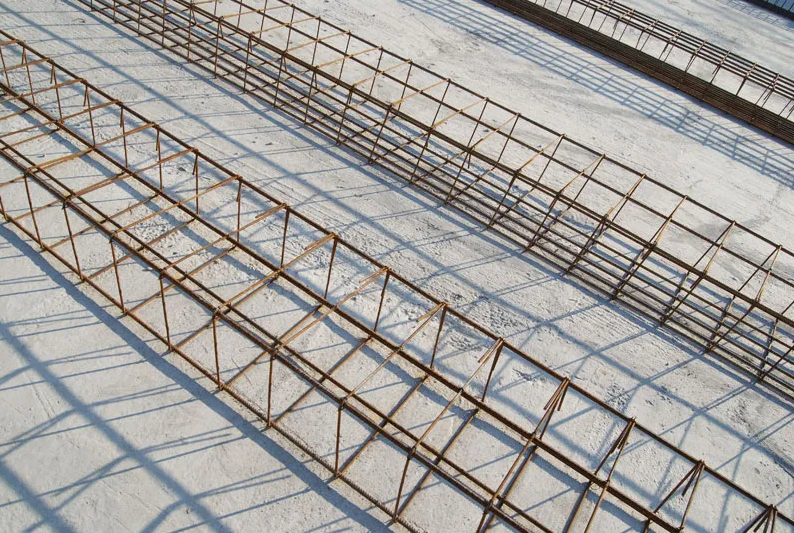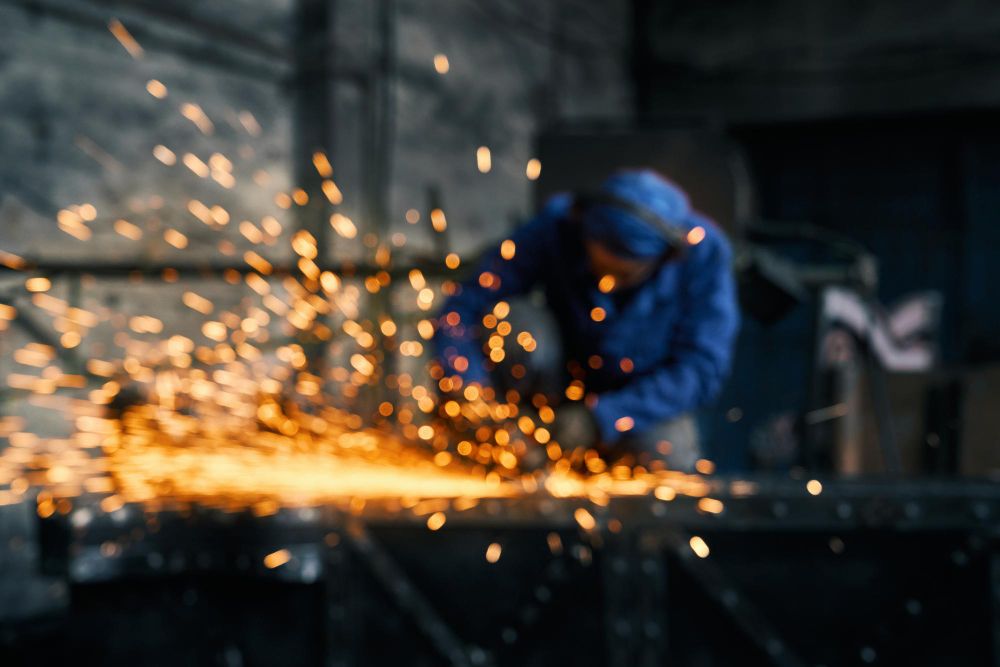A Guide to Reinforced Concrete: Materials & Applications

Reinforced concrete is the foundation of modern construction, forming everything from towering skyscrapers and complex bridges to resilient marine structures. Its strength comes from a remarkable synergy between two materials: concrete, with its immense compressive strength, and steel, which handles tensile forces.
Today’s guide will explore the core components that make up reinforced concrete and the principles behind material selection. We’ll also showcase how Hadeed Engineering’s expert approach ensures structural integrity from design to execution.
What is Reinforced Concrete?
Reinforced concrete (also referred to as reinforced cement concrete) is a composite material designed to leverage the best properties of concrete and steel. While plain concrete is exceptionally strong under compression, it is brittle and weak in tension, cracking easily under bending or stretching loads. By embedding steel reinforcing bars (rebar) within the concrete matrix, engineers create a structural system that can resist both compressive and tensile forces.
This combination makes reinforced concrete highly versatile, suitable for a wide range of applications, including bridges, tunnels, industrial facilities, and multi-storey buildings. It also offers durability and design flexibility, allowing engineers to meet demanding structural requirements while ensuring long service life.
The Core Materials in Reinforced Concrete
The final performance of reinforced concrete depends on the quality and proportions of its constituent materials. Each component plays a vital role in achieving the strength and durability required for a project.
1. Cement: The Binding Agent
Portland cement is the backbone of reinforced concrete. Through hydration, it binds all materials into a solid mass. Cement type is chosen based on structural needs and environmental exposure. The primary types specified under Australian Standard AS 3972 include:
- Type GP (General Purpose): Used for most general construction applications where special properties are not required.
- Type GB (General Blended): A blended cement that often incorporates fly ash or slag, improving workability and long-term durability.
- Type HE (High Early Strength): Achieves high concrete strength quickly, making it ideal for rapid construction schedules or cold weather concreting.
- Type LH (Low Heat): Designed for mass concrete pours like dams or thick foundations. It hydrates slowly to minimize internal heat generation and reduce the risk of thermal cracking.
- Type SR (Sulfate-Resisting): Essential for structures exposed to aggressive soils or water with high sulfate content, which can cause chemical degradation of the concrete.
2. Aggregates: The Structural Filler
Aggregates are the inert granular materials that form the concrete’s structural skeleton and make up 60-80% of its volume. They are broadly classified into two types:
- Fine aggregates (sand): These particles fill the gaps between coarse aggregates, reducing the amount of cement paste needed.
- Coarse aggregates (gravel and crushed stone): They form the primary load-bearing framework. The maximum aggregate size is carefully chosen to ensure it can fit between reinforcing bars for proper consolidation.
3. Steel Reinforcement: The Tensile Backbone
Steel reinforcement transforms brittle concrete into a ductile material capable of safely resisting tensile and shear forces.
- Grades: Common rebar grades in Australia include D500N (normal ductility), with a yield strength of 500 MPa, as specified in AS/NZS 4671:2019
- Surface: Modern rebar is deformed with ribs that ensure a superior mechanical bond with the surrounding concrete.
- Sizes: Typically range from 8 mm to 40 mm in diameter.
4. Water: The Catalyst for Strength
Water activates the chemical hydration of cement (the reaction that gives concrete its strength). The water-to-cement (w/c) ratio determines concrete strength and durability. Lower w/c ratio leads to higher strength as it creates a denser, less porous cement paste.
A ratio between 0.40 and 0.60 is standard for most structural applications.
5. Chemical Admixtures: Performance-Enhancing Modifiers
Chemicals added to the concrete mix to modify its properties for specific project needs.
- Superplasticizers (High-Range Water Reducers): These aid in creating highly workable, flowing concrete with a very low w/c ratio, essential for achieving high concrete strength.
- Retarders and Accelerators: Retarders slow down the setting time, crucial for large pours or in hot weather, while accelerators speed it up for cold-weather construction.
- Air-Entraining Admixtures: These create a network of microscopic air bubbles in the concrete, providing relief pathways for water pressure during freeze-thaw cycles and dramatically improving durability in cold climates.
- Specialty Admixtures: Include corrosion inhibitors, shrinkage-reducing admixtures, and waterproofing agents used to enhance the durability of the reinforced concrete structure.
Engineering Principles for Material Selection
Choosing the right mix for reinforced concrete goes beyond selecting individual materials. Engineers must balance strength, durability, and constructability to ensure long-term structural integrity.
1. Strength Requirements and Specifications
Concrete compressive strength underpins design decisions:
- Structural concrete in Australia typically ranges from 20 MPa for footings and residential slabs to over 100 MPa in high-rise or infrastructure projects.
- Strength development is influenced by the water-cement ratio (as described by Abrams’ law), cement type, mix proportions, and aggregate quality.
- AS 3600:2018 specifies the minimum characteristic compressive strengths required for different structural applications, ensuring that adequate safety margins are built into every design.
2. Durability Considerations
Environmental exposure classifications in AS 3600 play a central role in material selection:
- Marine and coastal structures require low-permeability concrete and often the use of sulfate-resisting cement.
- Aggressive soils and groundwater may demand blends incorporating fly ash, slag, or silica fume to improve resistance to chemical attack.
- Controlling shrinkage and thermal cracking in hot climates is critical, making mix design and curing practices particularly important.
- Durability decisions directly influence service life and help minimise long-term maintenance costs.
3. Workability and Constructability
For reinforced concrete to perform well on site, it must be workable enough to be placed and compacted without segregation:
- Workability in Australia is typically measured using the slump test (AS 1012.3).
- Aggregate size and shape affect how easily concrete can flow around reinforcement and into formwork.
- Chemical admixtures are widely used to maintain workability while keeping the water-cement ratio low.
Quality Control and Testing Standards
The reliability of reinforced concrete depends not only on design and materials but also on rigorous testing throughout construction. Quality control ensures that each batch meets the specified requirements.
I. Fresh Concrete Testing
- Slump test: Assesses consistency and workability at delivery.
- Temperature checks: Prevent thermal cracking in large pours and maintain hydration control.
- Unit weight/density (AS 1012.5): Confirms correct batching and mix proportions.
II. Hardened Concrete Testing
- Compressive strength tests (AS 1012.9): Typically carried out at 7 and 28 days to verify compliance with the specified strength.
- Flexural and tensile tests: Applied where pavement or crack control requirements are critical.
- Durability tests: Such as chloride permeability testing for marine structures.
III. Structural Integrity Verification
- Reinforcement inspections: Confirm bar sizes, spacing, and cover depth before pouring.
- Proper consolidation: Ensures concrete fully encapsulates reinforcement, avoiding honeycombing or voids.
- Non-destructive testing (e.g., ultrasonic pulse velocity): Provides insights into uniformity and long-term performance.
Applications of Reinforced Concrete in Modern Projects
Reinforced concrete is widely chosen because it combines structural performance with adaptability. Its ability to handle both compressive and tensile forces makes it suitable for projects of all scales, from residential slabs to complex infrastructure:
- Commercial buildings: Used for columns, beams, and floor systems that require both strength and design flexibility.
- Bridges and tunnels: Provides durability under heavy loads and challenging environmental conditions.
- High-rise structures: Enables tall, slender designs while meeting stringent safety standards.
- Marine and coastal works: Offers long-term resistance when designed with low-permeability concrete and sulfate-resistant cement.
- Dams and water infrastructure: Delivers the strength and watertightness needed for reservoirs, spillways, and treatment plants.
Hadeed Engineering: Precision in Reinforced Concrete Design
At Hadeed Engineering, we bring reinforced concrete to its highest potential by uniting advanced engineering principles with modern digital tools. Using Building Information Modeling (BIM) and Finite Element Analysis (FEA), we analyse and detail every element before construction begins. This process allows us to optimise reinforcement layouts for safety and efficiency, detect and resolve clashes early, and produce precise, coordinated shop drawings that reduce errors and costly rework. Every design is held to strict Australian and international standards, strengthened by rigorous quality control and a client-first approach built on trust and clear communication.
Contact our team today to discuss how we can support your reinforced concrete requirements.



